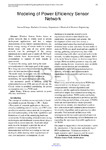Modeling of Power Efficiency Sensor Network
| dc.contributor.author | Kilungu, Duncan | |
| dc.date.accessioned | 2019-10-16T13:20:54Z | |
| dc.date.available | 2019-10-16T13:20:54Z | |
| dc.date.issued | 2019 | |
| dc.identifier.issn | 2229-5518 | |
| dc.identifier.uri | http://ir.mksu.ac.ke/handle/123456780/4910 | |
| dc.description.abstract | Wireless Sensor Nodes forms an ad-hoc network that is widely used in remote deployment applications and has a unique characteristic of low battery-operated devices, and hence energy saving of sensor nodes is a major design issue. Life span of any given sensor network can be prolonged if the energy minimization is taken care of under all ISO layer.Most scholar have demonstrated that energy consumption in support of node remain an unanswered. To analyze the energy spent during the node communication it’s the major goal of this paper. How long can a node be sustained during the time when the information is been shared. The model study investigate only two modulation techniques, BPSK and QAM if adopted in modulating the signal during transmission. The transmitter power is modeled using the relationship between SNR and cut-off rate and the Circuit power is modeled considering the power consumption used in a WSN node | en_US |
| dc.language.iso | en_US | en_US |
| dc.publisher | IJSER | en_US |
| dc.subject | Wireless | en_US |
| dc.subject | Sensor | en_US |
| dc.subject | Network | en_US |
| dc.title | Modeling of Power Efficiency Sensor Network | en_US |
| dc.type | Article | en_US |
Files in this item
This item appears in the following Collection(s)
-
School of Engineering and Technology [116]
Scholarly Articles by Faculty & Students in School of Engineering and Technology

